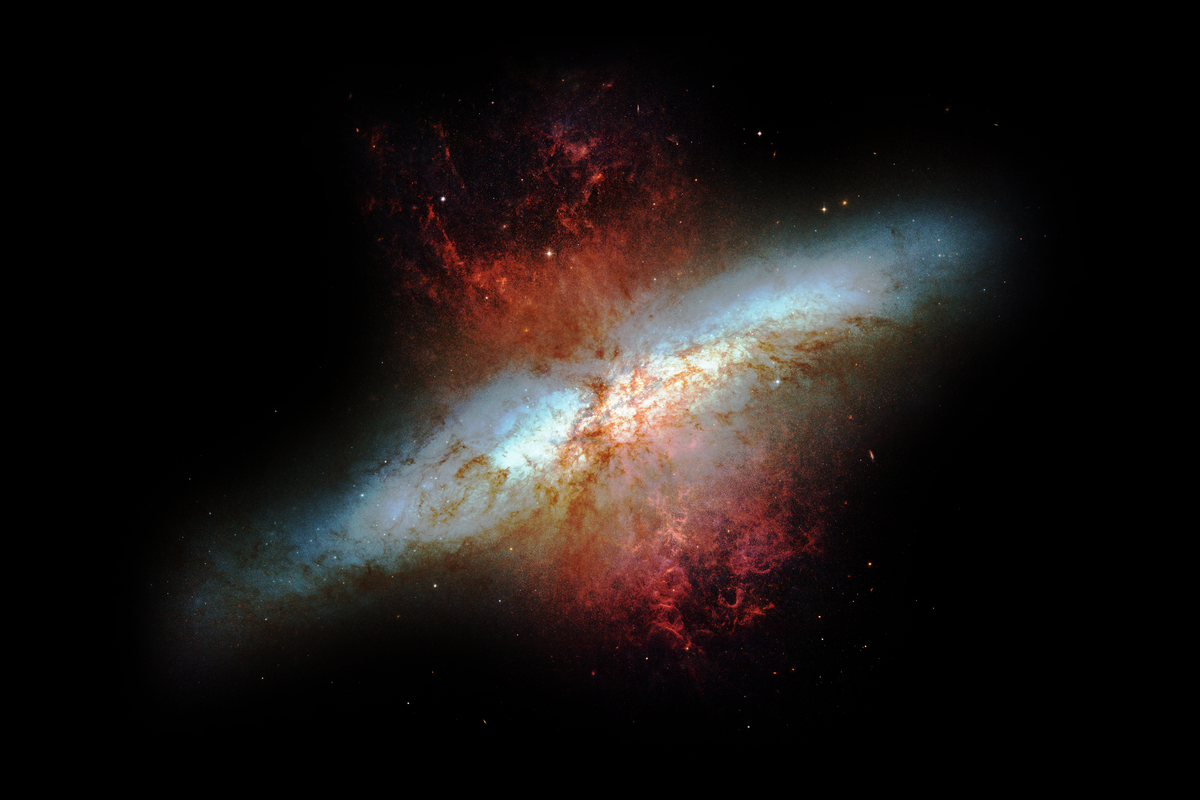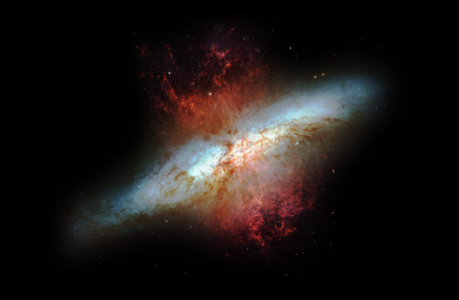The universe is a vast, mysterious place filled with countless wonders that leave us in awe of its beauty and complexity. One such wonder is the Cigar Galaxy, also known as M82. Situated in the constellation of Ursa Major, this fascinating galaxy has captured the imagination of astronomers and stargazers alike since its discovery in the late 18th century. With its striking appearance and intense activity, the Cigar Galaxy is a celestial firework that continues to fascinate scientists and space enthusiasts to this day.
The Cigar Galaxy is a spiral galaxy that is located approximately 12 million light-years away from Earth. It is about five times smaller than our Milky Way galaxy, but it is much more active and emits significantly more energy. The galaxy’s name comes from its distinctive shape, which resembles a cigar or a bullet. The Cigar Galaxy has a highly tilted disk, which gives it a unique appearance when viewed from Earth.
The Cigar Galaxy is known for its intense star-forming activity, which is fueled by the interaction between its stars and gas clouds. The galaxy’s central region is a hub of activity, with a supermassive black hole at its center that is responsible for the galaxy’s strong radio emissions. The Cigar Galaxy is also known for its powerful outflows of gas and dust, which can be seen in the form of jets that extend far beyond the galaxy’s disk.
The Cigar Galaxy’s intense activity has made it a prime target for astronomers who study the processes that drive star formation and galaxy evolution. In recent years, scientists have used a variety of telescopes and instruments to study the galaxy in unprecedented detail. One such instrument is the Atacama Large Millimeter/submillimeter Array (ALMA), which is located in Chile’s Atacama Desert. ALMA has provided scientists with detailed images of the Cigar Galaxy’s molecular gas and dust, which are crucial components for understanding star formation.
Another instrument that has been used to study the Cigar Galaxy is the Hubble Space Telescope. Hubble has captured stunning images of the galaxy’s structure and activity, including its powerful outflows and the jets of gas and dust that emanate from its center. These images have allowed scientists to study the galaxy’s properties in great detail and to gain insights into the processes that shape galaxies throughout the universe.
One of the most striking features of the Cigar Galaxy is its intense burst of star formation. The galaxy produces stars at a rate that is 10 times greater than that of the Milky Way. This starburst is thought to have been triggered by the interaction between the Cigar Galaxy and its neighbor, the spiral galaxy M81. The gravitational forces between the two galaxies have caused gas and dust to be pulled from the Cigar Galaxy’s disk, leading to a burst of star formation in its central region.
The Cigar Galaxy is also known for its high-energy emissions, which include X-rays and gamma rays. These emissions are produced by the galaxy’s active galactic nucleus (AGN), which is powered by a supermassive black hole at the galaxy’s center. The AGN produces intense radiation and jets of material that extend far beyond the galaxy’s disk. The Cigar Galaxy’s AGN has been studied extensively by scientists, who are trying to understand the processes that drive the activity of supermassive black holes in galaxies throughout the universe.
The Cigar Galaxy is a stunning example of the wonders of the universe. Its intense activity and unique structure have fascinated scientists and space enthusiasts for centuries, and its study has yielded important insights into the processes that drive star formation and galaxy evolution. As technology continues to advance, scientists will undoubtedly uncover new mysteries and revelations about this fascinating galaxy and others like it.
The Cigar Galaxy’s intense activity, including its starburst and powerful outflows, make it a prime target for further study. By studying this galaxy in greater detail, scientists hope to gain a better understanding of the processes that shape galaxies throughout the universe, including the formation of stars and the activity of supermassive black holes.
In conclusion, the Cigar Galaxy is a cosmic firework that continues to dazzle and inspire. Its unique shape, intense activity, and striking emissions make it a fascinating subject of study for scientists and a breathtaking sight for stargazers. As our understanding of the universe continues to evolve, the Cigar Galaxy and other wonders of the cosmos will undoubtedly continue to captivate and challenge us.
How to find the cigar galaxy
The Cigar Galaxy, also known as M82, can be found in the constellation of Ursa Major. It is located approximately 12 million light-years away from Earth and can be seen with binoculars or a telescope.
To find the Cigar Galaxy, you will need to locate the Big Dipper, which is one of the most recognizable asterisms in the sky. The Big Dipper is located in the constellation of Ursa Major and consists of seven bright stars that form a ladle shape.
Once you have located the Big Dipper, look for the two stars that form the outer edge of the ladle’s bowl. These stars are called Dubhe and Merak. Draw an imaginary line that connects these two stars and extends about five times their distance towards the north. You will see a bright star called Polaris, which marks the position of the north celestial pole.
From Polaris, move your telescope or binoculars about 16 degrees to the southeast to find the Cigar Galaxy. It will appear as a faint, elongated smudge of light. It is best observed on a clear, dark night away from light pollution.
If you are having trouble locating the Cigar Galaxy, you can also use a star chart or astronomy app to help guide you. With a little patience and persistence, you should be able to find this fascinating galaxy and witness its cosmic fireworks for yourself.
What causes the jets?
The jets seen emanating from the Cigar Galaxy (M82) are caused by the intense activity at the galaxy’s center, specifically its active galactic nucleus (AGN). An AGN is a compact region at the center of a galaxy that emits high-energy radiation and jets of material that extend far beyond the galaxy’s disk.
The AGN in the Cigar Galaxy is powered by a supermassive black hole at the galaxy’s center. As matter falls towards the black hole, it is heated to extremely high temperatures, emitting intense radiation in the form of X-rays and gamma rays. The strong gravitational forces of the black hole also cause the material to be accelerated to relativistic speeds, creating jets of high-energy particles that extend far beyond the galaxy’s disk.
The exact mechanism that drives the formation of these jets is not yet fully understood, but it is thought to be related to the strong magnetic fields that surround the black hole. These magnetic fields may help to focus and accelerate the material along the jets, causing it to travel at such high speeds.
The study of AGNs and their jets is an active area of research in astrophysics, and scientists continue to investigate the mechanisms that drive their activity. By studying these phenomena, scientists hope to gain a better understanding of the processes that shape galaxies and the universe as a whole.
Active galactic nucleus
An active galactic nucleus (AGN) is a highly energetic region at the center of some galaxies. AGNs emit large amounts of radiation across the electromagnetic spectrum, from radio waves to gamma rays, and are some of the most luminous objects in the universe.
The activity of an AGN is driven by a supermassive black hole at the center of the galaxy. Supermassive black holes are thought to be present in the centers of most galaxies, including our own Milky Way. They are extremely massive, with masses ranging from millions to billions of times that of our sun.
As matter falls towards the supermassive black hole, it is heated to extremely high temperatures and emits intense radiation in the form of X-rays and gamma rays. The strong gravitational forces of the black hole also cause the material to be accelerated to relativistic speeds, creating jets of high-energy particles that extend far beyond the galaxy’s disk.
The exact mechanism that drives the activity of AGNs is not yet fully understood, but it is thought to be related to the accretion of matter onto the supermassive black hole. The accretion disk is a disk of gas and dust that surrounds the black hole and provides the fuel for its activity. As matter falls towards the black hole, it heats up and emits radiation in the form of X-rays and gamma rays.
The activity of AGNs is thought to play a significant role in the evolution of galaxies. The energy released by AGNs can heat and ionize the gas in the galaxy, causing it to be expelled into the intergalactic medium. This can slow down or even halt the process of star formation in the galaxy, leading to a decline in its overall activity.
The study of AGNs is an active area of research in astrophysics, and scientists continue to investigate the mechanisms that drive their activity. By studying these phenomena, scientists hope to gain a better understanding of the processes that shape galaxies and the universe as a whole.

